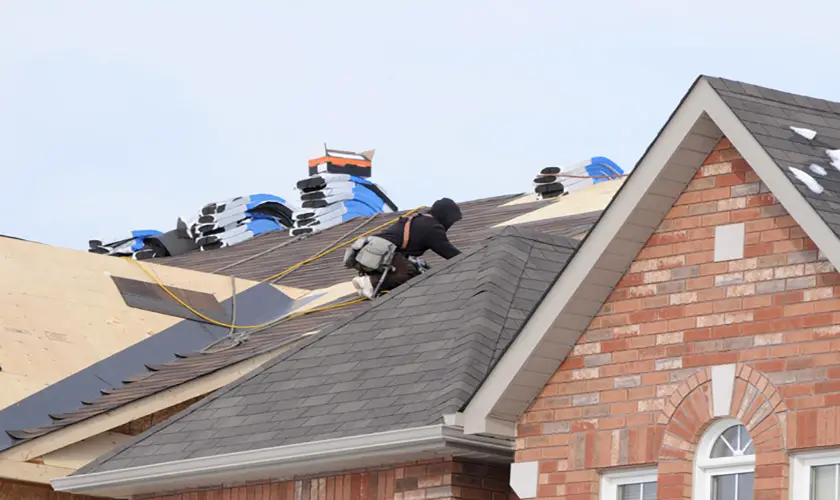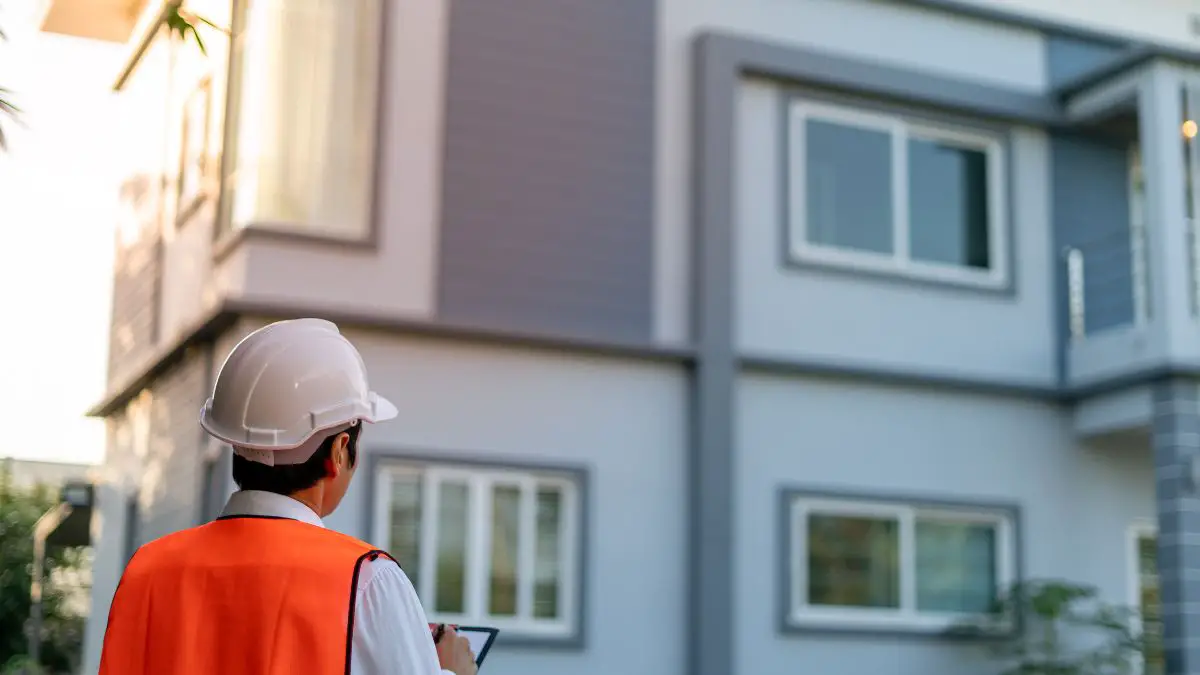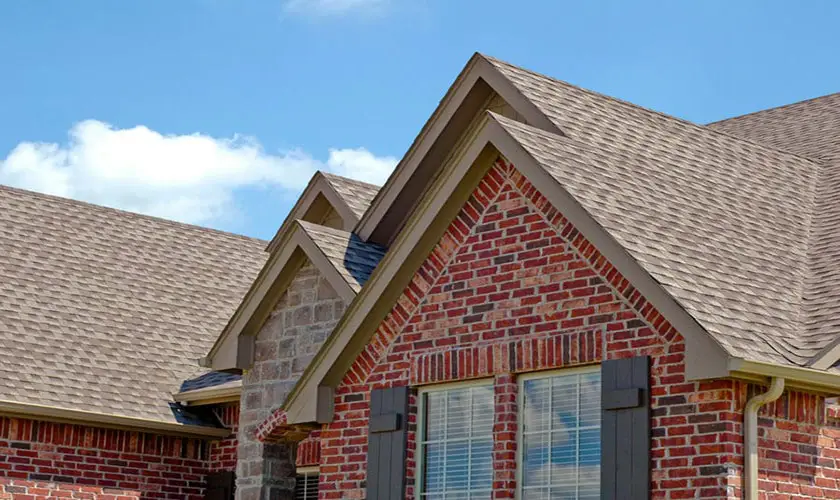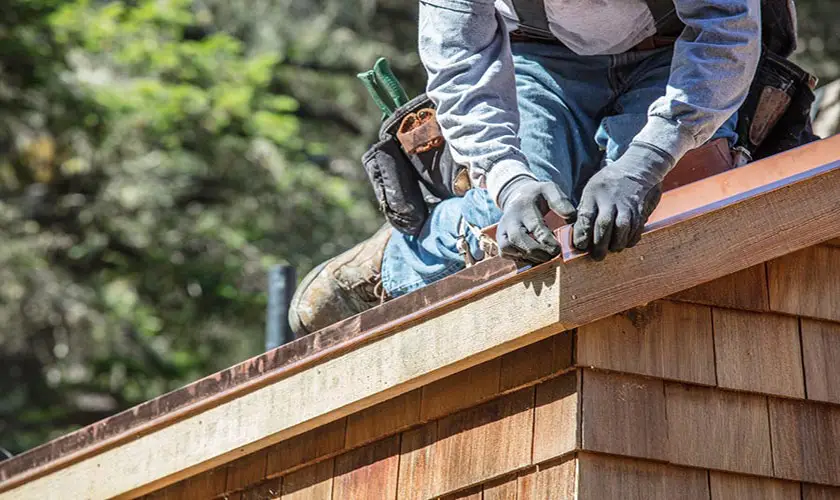
Synthetic roof underlayment offers dependability and affordability. However, five common problems with synthetic roof underlayment could put your home at risk.
While contractors appreciate this underlayment due to its protective nature and sustainability, improper installation may lead to costly problems with synthetic roof underlayment. By familiarizing yourself with these potential pitfalls now, you will be able to safeguard your home against severe damages in the future.
- Higher Cost Installation: Synthetic roof underlayment can be pricey due to its long life and superior material strength compared to felt or asphalt paper underlayment.
- Material Quality and Thickness: Numerous companies produce synthetic roof underlayment, albeit not all of them can guarantee excellent thickness and weight standards with their materials.
- Not All Roofs Need Synthetic Underlayment: Costly synthetic underlayments are not required on all roof installations. Check with your local building inspection office for local roofing codes to follow.
- Improper Installation: Poorly installed underlayments can ruin a new roof and can account for a multitude of problems, including roof leaks, fungal growth, and structure damage.
- Peel-and-Stick Can Be Difficult to Remove: Once applied, peel-and-stick synthetic products can be nearly impossible to remove without damaging the roof decking.
Roof underlayment has become an essential element of construction, providing undeniable results. Synthetic roof underlayment is one of the most reliable options due to its excellent durability and water resistance features.
However, certain drawbacks have led some constructors to opt for traditional roofing felt instead. It’s wise to consider these issues before making your final selection and investing in either synthetic or felt roof underlayment.
Before settling on synthetic roof underlayment for your project, it is essential to be familiar with the construction regulations in your area. These synthetic materials may not meet building code requirements prohibiting use in some locations. Check with your local building department before making a selection!
What is Synthetic Roof Underlayment
Synthetic roof underlayment is a type of underlayment that is the primary moisture barrier between your asphalt shingles and roof sheathing. Similar to traditional asphalt felt underlayment, it offers a barrier from moisture and high winds, which helps lengthen the lifespan of your roof materials by keeping them dry.
Synthetic roof underlayment is a protective layer made of synthetic materials, such as polyethylene plastic and lamination polypropylene, between the roofing material and roof decking of a building. It provides a superior layer of protection against water infiltration, wind, and other weather elements.
Why High-Quality Underlayment is Important
Although it is not required for some roofing projects, using an underlayment for your roof will lengthen its lifespan and increase safety. Research has shown that roofs without low-quality underlayment don’t last as long as those with a good-quality version.
Therefore, for the longevity of your roof, we highly recommend investing in a high-quality underlayment! There are several advantages to a high-quality synthetic roof underlayment, including:
- Protection from potential wind damage, which could otherwise lead to tearing.
- Upgrade your insulation and protect the comfort of your home from excessive drafts.
- Underlayment acts as a soundproof roof, creating an impenetrable barrier for rain or water sounds.
- Thicker roof underlayments can smooth out the roof surface area, making for an overall improved appearance.
- Many roof material warranties require a roof underlayment (felt or synthetic) to be valid.
Problems With Synthetic Roof Underlayment
Despite its immense popularity, synthetic roofing felt has pros and cons. To better understand these problems with synthetic roof underlayment and how to overcome them, here is a thorough analysis of the challenges associated with this type of roofing:
Synthetic Underlayments are More Expensive
Synthetic roof underlayment provides many advantages and protections against water infiltration, though it does come with a hefty price tag. Despite being significantly more expensive than other alternatives on the market, this underlayment has become increasingly popular due to its superior quality.
Synthetic materials can range between 17 to 25 cents per square foot – substantially more expensive than their traditional felt, typically costing around 5-10 cents.
Unfortunately, not everyone can afford such an extravagant purchase for their construction projects. Those who do will benefit from the unparalleled protection and durability that synthetic roof underlayments offer!
Often roofing contractors will charge lower prices and opt for more inexpensive synthetic materials. Often there is a direct correlation between material cost and quality. When selecting a roofing contractor, ask questions about the material weight and thickness, and verify they are installing the materials you requested.
Boasting robust quality and longevity, this underlayment stands out amongst the rest. However, it is rare to find comparable substitutes on the market – leading manufacturers of synthetic roof underlayment charge premium prices for their superior products.
The cost of synthetics is based on weight and performance. If a product has more advanced properties, like enhanced flexibility and resistance to wear and tear over long periods of time, it will likely be heavier in mass as well.
Nowadays, thinner synthetic products have prices similar to 15-pound felt with improved quality – albeit still pricier compared to lower-grade felts. Thicker synthetics can go up 30%-40% higher than their lighter weight alternatives.
Part of the pricing difference is that synthetic underlayments are lighter and come in larger rolls than felt. At 4 feet long and covering almost 1000 square footage per roll – that’s twice as much coverage compared to standard 3-foot roofing felt rolls.
These larger-sized rolls will have your roof done quicker than ever before. You no longer need to make multiple trips for additional materials; larger capacity means more ground covered with fewer resources.
Although synthetic underlayment may be a bit more costly than felt, it is undoubtedly worth the price in the long run. Investing in superior-quality synthetic materials today will prevent you from having to spend extra money on potential repairs later down the line.
The Material Weight and Thickness Varies Between Manufacturers
It is critical to research thoroughly to ensure you don’t purchase a poor-quality synthetic underlayment. Some are significantly better than others, even if they appear appealing. It’s smart to compare what synthetic versus felt underlayments have in store for your project so you can select the right one according to your needs!
When determining the quality of roof underlayment, thickness and weight are key factors. Unfortunately, with synthetic roof underlays now trending in popularity, different manufacturers have been taking advantage of customers by claiming their products meet high standards when they do not.
To ensure you get the highest quality synthetic roof underlayment, it is important to check for thickness in full rolls and test a sample of split material for water-resistant properties.
Unfortunately, this task can be daunting if buyers are unaware of what they should look out for when purchasing. Some sellers take advantage by selling low-grade products at premium prices, leaving customers with costly losses after investing money into something that isn’t up to standard.
When installing roofing aside from asphalt underlayment, ensure that the synthetic underlayment is suitable for your needs – not all types of underlayment can be used with all kinds of roofing materials.
Durability Concerns with Synthetic Roof Underlayment
Our last point leads to durability concerns with synthetic roofing underlayment products. Although some manufacturers promise high-quality materials and superior performance, there is an increased risk of lower durability, which can affect a roof’s lifespan.
When purchasing roof underlayment, opt for the highest quality product made of polyethylene plastic and lamination polypropylene. You should look closely at the material thickness and weight. Generally speaking, heavier roof underlayments often demand an additional cost when it comes to installation, which can add up quickly if not considered beforehand.
Ensure you get a trustworthy and reliable underlayment by searching for established companies with stellar reviews. Careful evaluation will help guarantee your synthetic roofing underlayment’s best quality and durability to avoid deceptive products.
Every Roof Does Not Need Synthetic Underlayment
Roofing contractors must adhere to local building regulations in most areas. However, some areas still do not require a building permit for a roof replacement. Likewise, not all roof coverings require a synthetic underlayment.
Synthetic roof underlayment is not always allowed; therefore, roofing companies should review local building guidelines before making any decisions regarding this material. If synthetic roofing materials are used without being permitted by the regulations, it can result in major legal issues down the line.
Before deciding on a roofing underlayment, it’s crucial to research local building standards. They may require its use and provide information on the kind. In rare instances, a felt roofing underlayment might even be preferred. This is an exception rather than the rule but worth bearing in mind!
Problems with Improper Installation
It is essential to seek the help of a reliable and experienced installer when installing synthetic roof underlayment, as inexperienced installers or improper installation can result in moisture or fire resistance issues. The poor installation process will cause problems with synthetic roof underlayment.
Roof Leaks
The most obvious risk associated with improper installation of synthetic roof underlayment is water damage caused by roof leaks around seams and nail penetrations. Even the slightest gap or hole in your underlayment can lead to water seepage that can do a lot of damage over time.
Structural Damage
Synthetic roof underlayment can cause structural damage due to faulty installation. They could eventually give way and result in costly repairs or total roof replacements if left unchecked for long enough. You can avoid such costly issues by ensuring that all steps in the process are done correctly from start to finish.
Low Perm Rating
In contrast to felt, synthetic products generally have much lower perm ratings. As a result, moisture accumulation in an attic cannot be released through the roof itself – so correct ventilation is necessary if your attic contains this type of material.
Often, roofing contractors will replace a roof and leave the existing ventilation in place without regard to how the attic is venting. We see this often when roofers install ridge vents with gable vents present and no soffit venting.
Ridge vents need soffit vents to function properly, as they work together to remove hot air from the attic. Roofing crews will install ridge vents because the local building code says they have to, yet they won’t verify the attic venting is sufficient.
If your attic lacks sufficient ventilation, the hot air can’t escape causing the roof decking to condensate (or sweat). These conditions are ideal for mold growth. Mold is unsightly and potentially hazardous, so it’s best to take care of the issue immediately before it gets out of hand.
Peel-and-Stick Synthetic Underlayment Can be Hard to Remove
Peel and stick are types of underlayment with strong adhesion backing that sticks directly to the roof sheathing. It’s the right material for protection from ice and wind-driven rain. Common applications include metal roofs and along eaves where there are risks from ice dams or high winds.
To adhere to local roofing codes, you must consult with your building officials to determine if peel-and-stick materials are allowed. Synthetic underlayment should always accompany self-adhering or ice & water membranes when covering overhangs, valleys, and wall intersections.
Peel and stick roofing problems can arise when attempting to remove it. Lifting this material might be difficult and time-consuming, depending on the adhesion backing. We recommend you seek professional advice if wanting to replace synthetic roof underlayment with an alternative option.
Primarily, people are concerned about what will occur when it’s time to re-roof. Generally speaking, the previous underlayment must be taken out before installing anew. Many people wonder if peel-and-stick materials could possibly make that process more difficult.
Due to the powerful adhesive designed for lasting durability, removing peel-and-stick underlayment can be troublesome. Generally, if you remove it, the OSB roof decking will unavoidably sustain damages; therefore, replacing both would typically be your best choice.
You can opt for two layers of synthetic underlayment roofing with the first layer of a non-stick synthetic underlayment, then attach peel-and-stick material directly over it. Even though it makes removal easier, there’s no need for two layers of underlayment and the extra cost you’d incur.
When attaching the peel-and-stick underlayment directly to a non-stick underlayment, some advantages, such as increased wind resistance or protection from moisture penetration, could be lost – both necessary components for a successful application.
Contractors and homeowners alike are concerned that peel-and-stick underlayment may be difficult to remove later, resulting in expensive roof deck replacement due to potential damage caused by the removal process.
When properly installed, peel-and-stick underlayment does not need to be removed unless it has been severely damaged, such as by a storm. However, if two or more layers of underlayment are on the roof, all must be taken off and replaced. Additionally, when the deck beneath a peel-and-stick is altered in any way, removal becomes necessary regardless.
Synthetic Roof Underlayment Does Have Many Advantages
Synthetic roof underlayment provides an unsurpassed degree of water resistance due to its unique combination of polypropylene and polyethylene fibers. This makes the material highly impermeable, ensuring reliable protection against leakage.
Synthetic roof underlayment is resistant to mold and mildew and stands the test of time, with a lifespan averaging 15 to 40 years, depending on the product.
Asphalt felt needs to be covered immediately. When left exposed, it is subject to becoming brittle from UV damage rather quickly. If it gets wet, it might start to wrinkle; if it’s cold, it might crack; if it’s too hot or has too much UV light, it will break down. So we only used asphalt felt when we could finish the roofing process in one day.
On the other hand, the best synthetic roof underlayments are moisture-resistant and can withstand high temperatures when exposed. Additionally, most brands offer UV damage protection for six months to one year.
For example, the Epilay line of Protectite products – Platinum, Ultra, Superior, and Plasfelt – are all rated to withstand UV damage for one full year of exposure. At the same time, Plystick Plus can be exposed for up to six months without issue.
Furthermore, synthetic underlayment is much lighter than traditional tar paper, which makes for easier installation with potential labor cost savings as a bonus!
How to Avoid Potential Problems with Synthetic Roof Underlayment Installation
Despite the occasional issues that accompany synthetic roof underlayment, there are some measures you can take to guarantee your residence is safeguarded.
Choose a high-caliber roof covering when putting in or replacing your rooftop. Synthetic roofing materials come with various levels of quality and durability; hence it’s imperative to analyze which one will be most beneficial for protecting your home before making any decisions.
Selecting an item certified as dependable and secure will ensure your abode remains safe from the elements!
Hiring experienced and knowledgeable installers for your new roof is essential, as an incorrect installation can lead to moisture or fire resistance issues. Don’t forget to inquire about the installer’s warranty regarding their workmanship, so you can be confident that they will do a quality job.
To protect your home and ensure its safety, frequently inspect the roof for any signs of damage in the synthetic underlayment. Should you find any indications that all is not well, take swift action to correct them before they become critical. Although problems with synthetic roof underlayment may arise, there are proactive steps you can take to avoid costly repairs or replacements down the line.
Alternatives to Using Synthetic Roof Underlayment
If you’re worried about synthetic roof underlayment issues, there are a few other options to explore.
Opt for time-proven felt paper for keeping moisture out, as this material is more resilient and adept at blocking leaks than synthetic alternatives.
Consider installing a rubber membrane on the synthetic underlayment to protect your roof further. Usually reserved for more expensive metal roofing installations, this will safeguard against moisture and leaks and enhance fire protection by forming an additional layer of defense.
Benefits of Professional Roofing Installation for Installing a New Roof
Investing in a new roof system is one of the most impactful decisions you can make for your home. Professional installation services ensure the job is carried out correctly and with long-term satisfaction. Here are just a few advantages of using an expert service:
Expertise
Professional installers possess the training and expertise to guarantee a problem-free experience, with installations completed precisely and compliant.
Better Materials
Professional installers ensure that top-notch materials remain robust over the long haul and protect your abode from moisture damage and other roofing complications. By securing quality supplies, you can rest easy knowing that you invested in protecting your home for years to come.
Save Time and Money
With the help of professional installation services, you can save time and money in the long run. Professional installers are more efficient than DIY installations, thus allowing you to spend less time on laborious tasks.
Warranty
Professional installers commonly provide warranty options for their labor, offering assurance that any issues with the roof installation can be addressed if they come up. This gives you a sense of comfort and confidence, knowing that your roofing contractor will cover problems with synthetic roof underlayment if something goes wrong.
FAQs About Problems with Synthetic Roof Underlayment
Will synthetic underlayment leak?
To avoid any issues with roof leaks, select a high-caliber product from a dependable manufacturer and ensure the installers are well-versed in their craft. Occasionally, problems with synthetic roof underlayment can occur due to installation faults. Therefore you must hire experienced professionals for your roofing project to ensure proper material installation.
Is synthetic roofing underlayment good?
Synthetic underlayment is the right choice if you want the best roofing protection. However, it is important to make sure that installers are knowledgeable and use high-quality materials to prevent any potential issues down the line. Investing in quality now will save time and money later on!
Which is better, roofing felt or synthetic underlayment?
Compared to traditional felt, synthetic underlayment is far more resilient due to its construction from plastic, rubber, or PVC materials. Plus, it provides better protection against water and moisture damage than standard felt. That being said, installing the latter may be cheaper and less time-consuming.
How long does synthetic underlayment last?
To guarantee that your synthetic underlayment lasts up to 30 years, hire experienced installers and only use top-notch materials. This way, you can rest assured knowing that your investment will continue providing exceptional results without fail.
Conclusion
By doing the proper research and taking necessary precautions, any issues with synthetic roof underlayment can be prevented. Investing in a high-quality roofing system is important, so ensuring your home is secure should always be on your list of priorities. Experienced professionals can pinpoint potential areas of concern and take corrective measures as needed for future protection.






